West of Fife Mineral Railway
Introduction
This railway is closed. It formed a network of lines to the north of Dunfermline. The lines were minerals only and served mines and works. Initially it ran north to Steelend, meandering through the coal field, with a branches to Kingseat and Roscobie. It was extended progressively including a line to Kelty which was opened by the North British Railway after their purchase of the line.
There were signal boxes at Lilliehill Junction and Lassodie Junction. A planned box at Lindsay Colliery did not open.
Dates
Portions of line and locations
This line is divided into a number of portions.
Whitemyre to Steelend
Opened 1858.
This was a junction in the west of Dunfermline. It was a pair of junctions. The older junction was Charlestown Junction [Whitemyre] which opened between the Stirling and Dunfermline Railway of 1849 and a short branch south east to the Charlestown Railway.
...
See also
Stirling and Dunfermline Railway
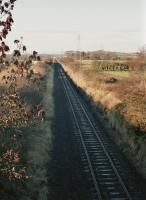
Bill Roberton //1985
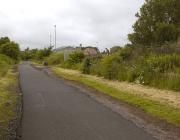
Bill Roberton 27/06/2008
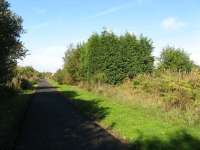
Mark Poustie 23/09/2006
This was the junction between the Lochhead branch and the West of Fife line. Both lines were single track mineral railways to the north of Dunfermline.
...

Grant Robertson 19/03/2008

Bill Roberton 07/03/2008
This was a four way junction north of Dunfermline and Townhill. The lines meeting here were goods and minerals only and single track.
...
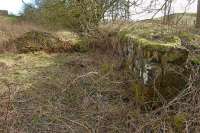
Bill Roberton 11/03/2012

Grant Robertson 12/02/2012
This was a small goods station, a loop on the north side of the line with a loading bank. To the west was a railway cottage (the agent's house) which still stands. The goods station was a railhead for the surrounding area. To the west the line continued by a level crossing to the Steelend Mines (Saline Valley Colliery). To the east it ran to Gask Junction and on to Lilliehill Junction ...
More details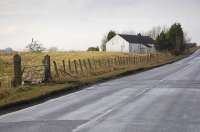
Bill Roberton 30/01/2012
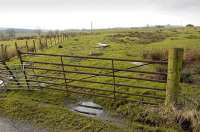
Bill Roberton 30/01/2012
Lilliehill to Kingseat
Opened 1858 to Kingseat Colliery.
This was a four way junction north of Dunfermline and Townhill. The lines meeting here were goods and minerals only and single track.
...
Rescobie (or Gask) Branch
Opened 1858. Noted for the Lathalmond depot.

Bill Roberton 11/03/2012

Grant Robertson 12/02/2012
This was a rail served Royal Naval Stores Depot established in the Second World War.
...
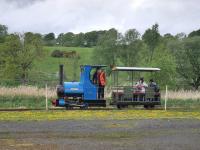
...
Bill Roberton 22/05/2022
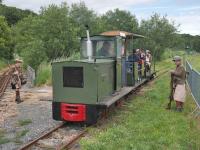
Bill Roberton 03/07/2022
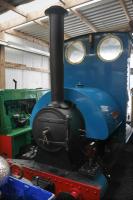
Bill Roberton 08/06/2022
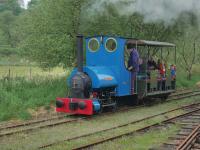
Bill Roberton 21/05/2023
This siding was at the east end of the Lathalmond Branch. The siding was in fact a loop serving a loading stage. The looped and bank were on the north side of the line. By 1895 this was the end of the branch which had continued east to Lassodie Colliery.
...
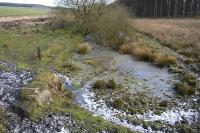
Bill Roberton 05/01/2012
Kingseat to Kelty
Completed by the North British Railway, (who took over the line in 1862), from Kingseat to Lassodie Colliery in 1862 and from Lassodie to Kelty 1863 to connect the system to the yards at Kelty.
This junction was on the West of Fife Mineral system north of Dunfermline and south west of Kelty. The line from Kingseat Colliery to Lassodie Colliery opened around 1862. This junction opened in 1863 and connected that line to Kelty allowing through running from Dunfermline to Kelty.
...

Bill Roberton 03/03/2009
This was a Fife Coal Co Ltd pit. It was located on the east side of the West of Fife Mineral Railway in the east of the village of Kelty and south of Kelty North Junction. This railway was a single track minerals line which ran south to Townhill and Dunfermline.
...

Bill Roberton 30/01/2012
This was a six way junction immediately north of Kelty station.
...
See also
Lochore Branch (North British Railway)
Blairenbathie and Blairadam Collieries Branch (North British Railway)
Kinross-shire Railway
Lassodie Colliery Branch
Possibly 1862. Opened by NB, private later. Was possibly a through route between Lassodie Junction and Gask Junction until 1880s.
1869 Charles Jopp map shows nothing between Gask and Lassodie https://maps.nls.uk/view/216546872
Aireys 1875 map shows a gap between Gask Siding and Craigduckie, and no triangular junction to east.
NBR 1882 map shows same
Emslies 1898 map shows a straight through route, but privately owned between Gask Siding and Lassodie Junction.
Emslies 1907 map ditto
Emslies 1915 map shows a gap and Lassodie Colliery to Lassodie Junction privately owned.
Emslies 1920 map ditto
This junction was on the West of Fife Mineral system north of Dunfermline and south west of Kelty. The line from Kingseat Colliery to Lassodie Colliery opened around 1862. This junction opened in 1863 and connected that line to Kelty allowing through running from Dunfermline to Kelty.
...
This siding was at the east end of the Lathalmond Branch. The siding was in fact a loop serving a loading stage. The looped and bank were on the north side of the line. By 1895 this was the end of the branch which had continued east to Lassodie Colliery.
...

Bill Roberton 05/01/2012
Elgin Colliery Branch
This branch served the Elgin Colliery, originally served by the Elgin Railway, part of which became incorporated or relaid. The main stem ran north with a branch running west to Rosebank serving several mines. The principal route continued north to a reversing spur at Balmule from which further collieries and Lochhead works could be reached. Parts opened in 1863.
This was the junction between the Lochhead branch and the West of Fife line. Both lines were single track mineral railways to the north of Dunfermline.
...

Grant Robertson 19/03/2008

Bill Roberton 07/03/2008
This junction was at the north end of the West of Fife Mineral Railway's Elgin Colliery branch. It was close to the end of the branch near Elgin Colliery Arthur Pit. Reversal at the junction allowed access to Elgin Colliery Balmule Pit, Elgin Colliery Drumtuthil Pit and Lochhead Fire Clay Works.
...
Elgin Colliery Tramway
This tramway ran south from Rosebank No 2 to Hunter Pit (formerly served by a Elgin Railway tramway) and Fernieknowe Pit.
Townhill to Lilliehill
Incorporating portions of the old Townhill Waggonway this opened in 1880. This allowed minerals to flow west through Dunfermline on to Oakley and Stirling. The Forth Iron Works at Oakley would have benefited, before its closure in 1890.
The 1866 West of Fife Railway and Harbour, for Charlestown, met the 1849 Dunfermline Branch (Edinburgh and Northern Railway) at this junction. The location was just west of the Townhill Tramway route and Halbeath. Approach to the Charlestown line was from the east, the line running south west. The Dunfermline and Queensferry to the line to North Queensferry [1st] ...
More detailsSee also
Dunfermline Branch (Edinburgh and Northern Railway)
West of Fife Railway and Harbour
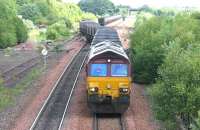
John Furnevel 13/06/2006
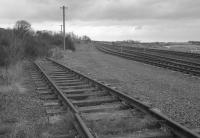
Bill Roberton //1992
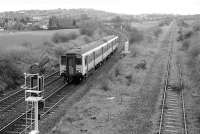
Bill Roberton 15/04/1992
This was a rail served power station located to the north of Townhill Loch, north of Dunfermline opened in August of 1905 by the Fife Electric Power Company. The power station was a chain grate coal fired power station.
...
This was a four way junction north of Dunfermline and Townhill. The lines meeting here were goods and minerals only and single track.
...
Lassodie Loop
Roscobie Lime Works Tramway
This siding was at the east end of the Lathalmond Branch. The siding was in fact a loop serving a loading stage. The looped and bank were on the north side of the line. By 1895 this was the end of the branch which had continued east to Lassodie Colliery.
...

Bill Roberton 05/01/2012

Bill Roberton //1993
Kelty Loading Point
Opened during the Second World War as an opencast loading point.
This was a coal loading point with stocking. The facility was opened by the Ministry of Fuel and Power which was created in 1942 during the Second World War.
...
Books
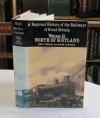 A Regional History of the Railways of Great Britain: The North of Scotland v. 15 (Regional railway history series) | 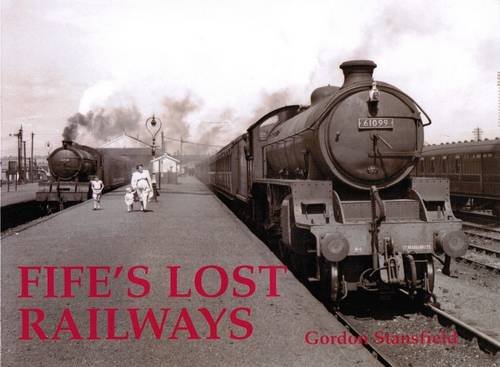 Fife's Lost Railways |  Railways of Fife |  The Railways of Fife |










